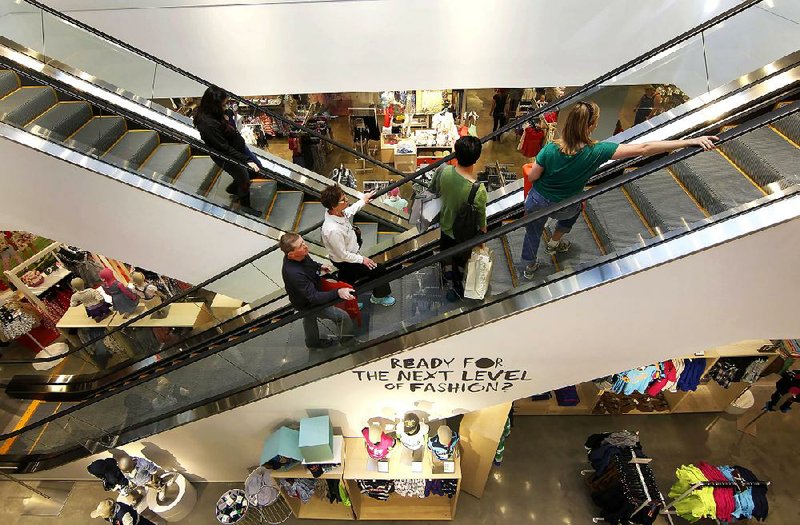LITTLE ROCK — A widely watched barometer of consumer confidence barely budged in March, despite mixed economic signs.
The stock market has jumped since the start of the year, but gasoline prices are climbing. Unemployment is falling, but home prices also are declining.
Lynn Franco, director of private research group The Conference Board Consumer Research Center, said consumers “feel the economy is not losing momentum.”
The Conference Board said Tuesday that its Consumer Confidence Index fell slightly to 70.2. That’s down from a revised 71.6 in February - the highest level it’s been since the same month in 2011.
Consumer confidence has made a recovery since it fell to an all-time low of 25.3 in February 2009. But the March reading remains below the 90 that indicates a healthy economy. The index hasn’t been near 90 since December 2007.
“March goes out like a lamb,” wrote analysts from Credit Suisse. They expected better news in April, which has seen rising consumer confidence in 23 out of 34 years.
Economists watch consumer confidence closely because Americans’ spending on expenses from clothing to health-care accounts for about 70 percent of the nation’s economic activity.
One gauge of the Consumer Confidence Index, which measures how shoppers feel now about the economy, rose to 51.0, from 46.4 in the previous month. That measure now stands at the highest level inmore than three years. But the other barometer, which assesses shoppers’ six-month outlook, declined to 83.0 from 88.4 in February.
“The moderate decline was due solely to a less favorable short-term outlook, while consumers’ assessment of current conditions, on the other hand, continued to improve,” Franco said.
The preliminary survey of consumers, conducted from March 1 through March 15, showed shoppers’ worries about inflation rose to the highest level in a year, asgasoline prices rose. In fact, the nationwide average for a gallon of gasoline reached $3.90 on Tuesday, which is now less than 10 cents away from last year’s high.
The price typically climbs in the weeks ahead of Memorial Day weekend. The national average peaked last year in early May at an average of $3.98 per gallon. The record high of $4.11 was set in July 2008.
In Arkansas, the average price of a gallon of gasoline on Tuesday was $3.74, according to AAA.
But steady improvement in other areas of the economy is offsetting worries about gasoline prices. The economy expanded at an annual rate of 3 percent in the final three months of last year. That was better than the 1.8 percent rate in the previous quarter. Most economists expect growth to slow in the current quarter to below 2.5 percent, despitemore hiring.
Companies also are adding workers as the economy picks up. The economy has added an average of 245,000 jobs per month from December through February. The unemployment rate has declined to 8.3 percent, the lowest in three years.
Still, a job market recovery has a long way to go. According to Conference Board survey, shoppers’ assessment of jobs was mixed.
Those saying jobs “are plentiful” increased to 9.4 percent from 7.0 percent, while those stating jobs are “hard to get” also rose, to 41.0 percent from 38.6 percent. Additionally, consumers’ six-month outlook for the labor market was less upbeat: Those anticipating more jobsin the months ahead declined to 17.3 percent from 18.8 percent, while those anticipating fewer jobs increased to 18.3 percent from 16.4 percent.
Adding to that, a continued drop in home prices suggests the housing market remains weak, even after the bestwinter for home sales in five years and steady improvement in the job market.
A widely watched home price index showed that home prices fell in January for a fifth straight month in most major U.S. cities, as modest sales increases have yet to raise prices. The Standard & Poor’s/Case-Shiller homeprice index released Tuesday showed that prices dropped in January from December in 16 of 19 cities tracked.
The steepest declines were in San Francisco, Atlanta and Portland. Prices increased in Miami, Phoenix and Washington. Price information for Charlotte was delayed and therefore not included in the report.
The declines partly reflect typical offseason sales.
Eight cities - Atlanta, Chicago, Cleveland, Las Vegas, New York, Portland, Seattle and Tampa, Fla. - are now back at 2000 levels or earlier. Only Denver, Detroit and Phoenix posted yearover-year increases.
Information for this article was contributed by Anne D’Innocenzio and Derek Kravitz of The Associated Press and Tiffany Hsu of the Los Angeles Times.
Business, Pages 27 on 03/28/2012
